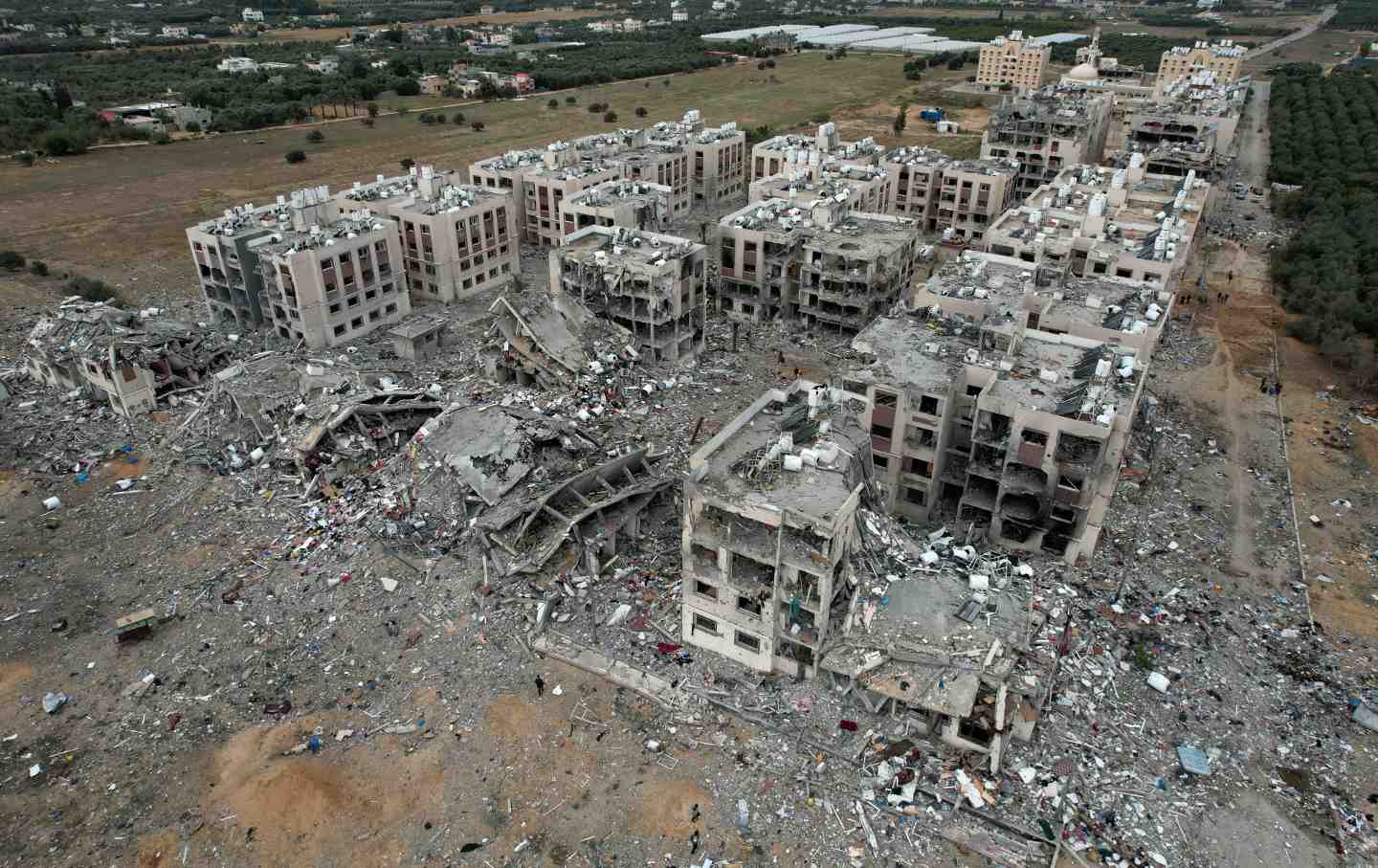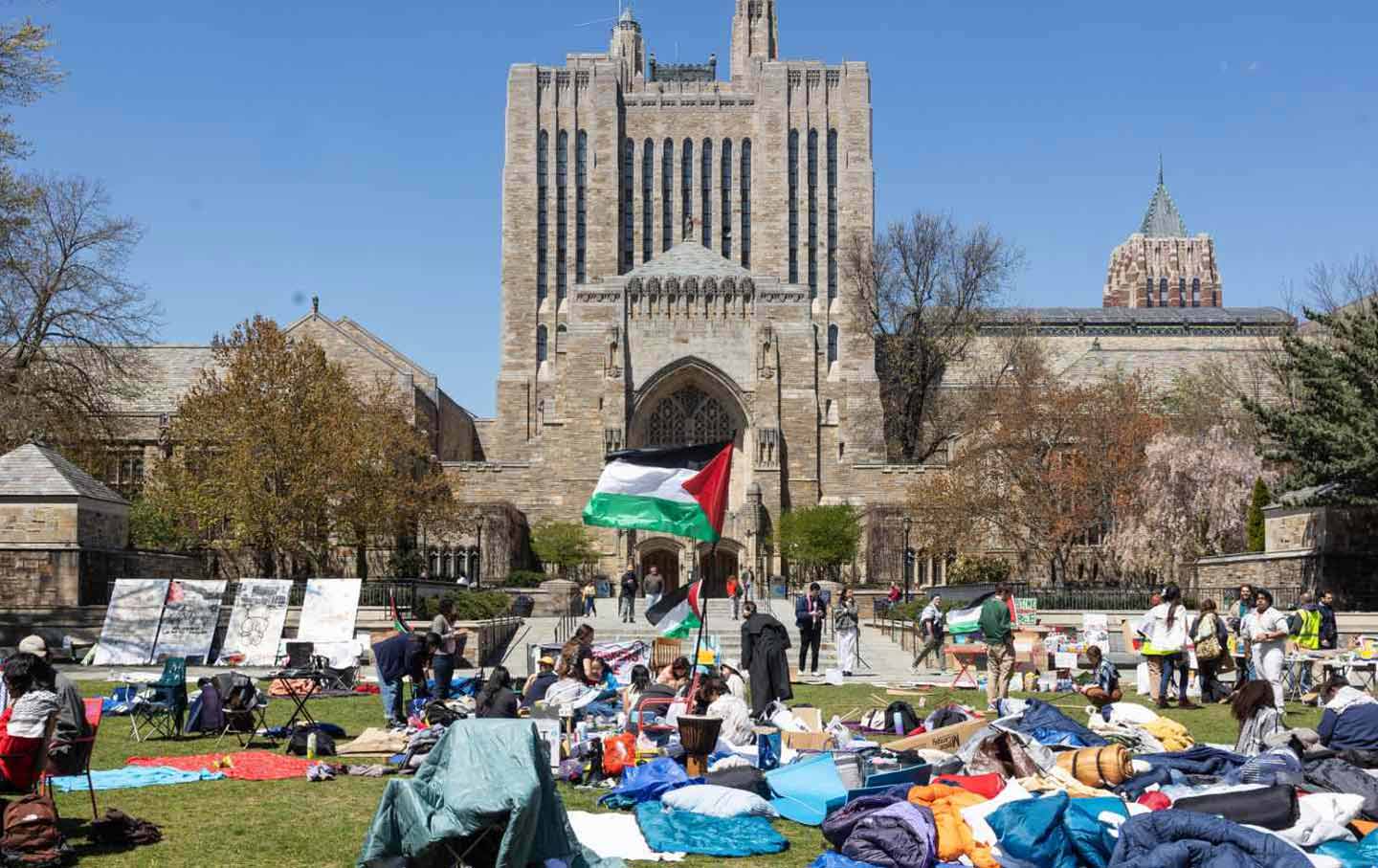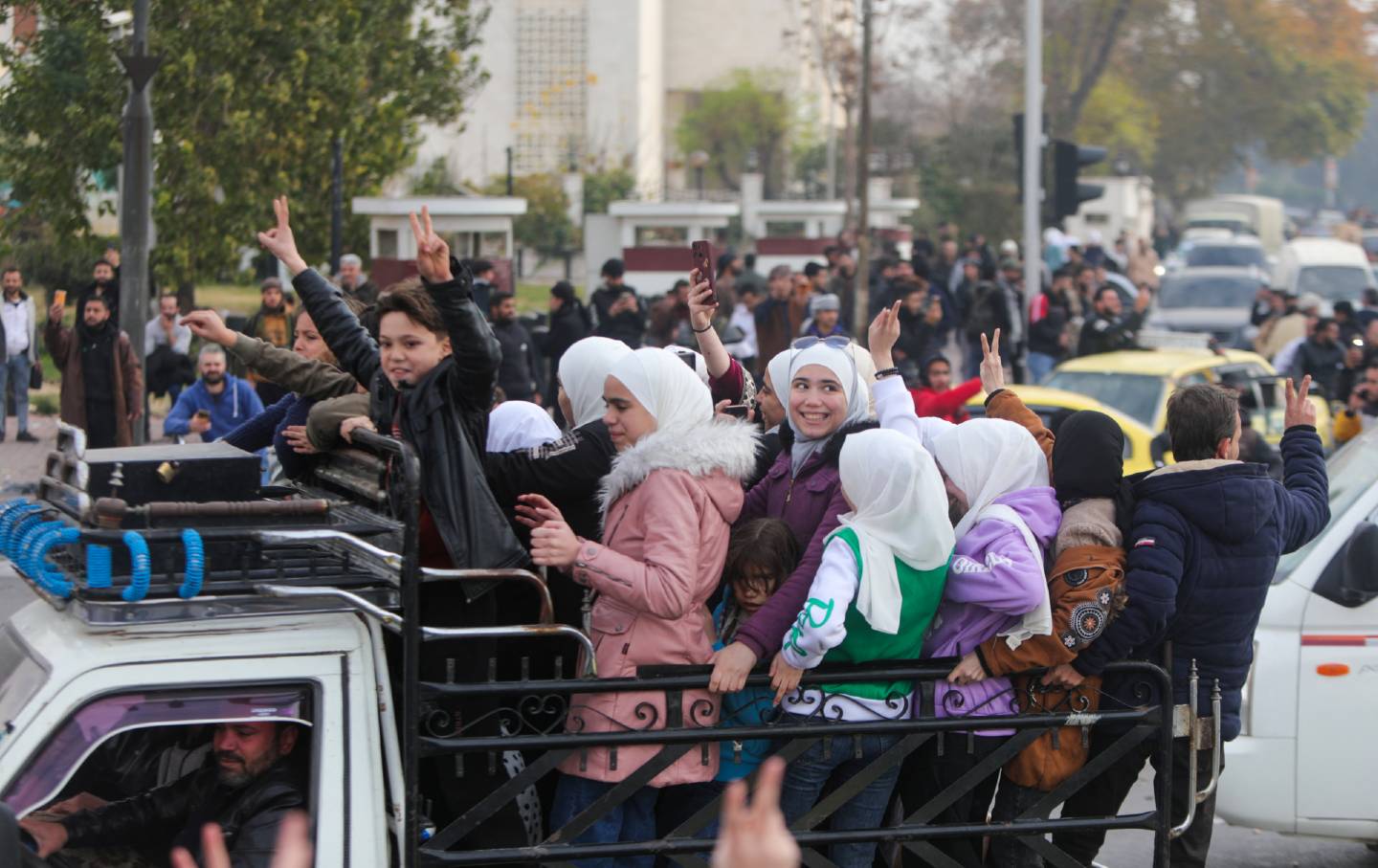The “Hunt for Hamas” Narrative Is Obscuring Israel’s Real Plans for Gaza
The US press and politicians are trying to fit the attacks on Gaza into a Zero Dark Thirty mold, but it’s something much simpler—and sinister.

An aerial view shows the destruction caused by Israeli strikes in Wadi Gaza, in the central Gaza Strip, on November 28, 2023, amid a truce in battles between Israel and Hamas.
(Mahmud Hams / AFP / Getty)America’s media and political class is analyzing, debating, and shaping a narrative in Gaza that’s entirely different from the one being discussed in Israeli media and among Israeli political leaders. This gap, born from casual racism, deliberate credulity, and reflexive alignment with the US government’s party line, is creating a media failure the likes of which we haven’t seen since the run-up to the Iraq War.
Israel is engaging in massive population transfers and attempting to depopulate Gaza, and everything it does must be understood through this lens. The Israeli government has explicitly said this from the beginning, starting with an evacuation order for North Gaza on October 13. No exceptions.
Everything Israel has done since then is pursuant to carrying out this evacuation order to remove over 1 million people form North Gaza into refugee camps in South Gaza. This is what they said they would do, and it’s what they are doing.
Yet, throughout November, American media continued to frame every Israeli Defense Forces action in North Gaza as if every target they attempted to clear out was part of some elaborate “hunt for Hamas.”
The most prominent example is the weeks-long build up to Israel’s “raid” of al-Shifa hospital in mid-November. In the days leading up to the takeover of the medical complex, the American press repeatedly gave media consumers the impression Israel forces were storming the bin Laden compound in Abbottabad, Pakistan. Israeli Prime Minister Benjamin Netanyahu released a video showing an elaborate lair underneath the hospital complex, and US media largely ran with this claim.
“Israel’s hunt for Hamas puts Gaza’s al-Shifa Hospital under siege,” read The Washington Post headline. “Gaza City Hospitals Are Caught in Deadly Crossfire. Battling Hamas fighters, Israeli forces are ‘closing in’ on hospitals where thousands of people are stranded,” stated the New York Times headline.
The media gave American readers and viewers the impression that the Israeli military had to seize the hospital—and eight NICU babies along with dozens of other patients had to die—because this underground complex was “the beating heart of Hamas.” Then Israel took over the building and allegedly found some weapons, a single tunnel, a few underground rooms with two metal cots, and a bathroom—nothing remotely resembling the elaborate “command and control center” that was alleged. The IDF released video footage of a few hostages being brought into al-Shifa hospital on October 7, but this could very well have just been for medical care (dead hostages aren’t of much utility). The Israeli authorities have provided no other evidence that the underground complex was what they said it was. In The New York Times analysis just prior to Israel blowing up the shaft in question, the paper concluded that IDF-provided videos “have not shown conclusive evidence of a vast network of tunnels.”
The American public, also fueled by vague claims by the Biden White House, was fed a thrilling Zero Dark Thirty narrative that implied—and sometimes explicitly stated—that Israel was raiding Hamas’s primary headquarters located underneath and inside Al-Shifa Hospital. But when Israel showed up, there were no Hamas fighters, as Israel subsequently acknowledged. Israeli commandos just walked in and took control of a health-care facility.
So was the raid a “Hunt for Hamas” as the Post told its readers? Was the hospital caught in “deadly crossfire” as The New York Times implied? Hamas fighters no doubt attacked the Israeli military convoy as it made its way to the hospital, but all the reports heavily implying there was a shooting coming from inside the hospital were incorrect.
Looking at Israeli attacks through a “counterterror” lens makes Israel’s military decisions seem perplexing. Why would Israel attack a hospital if it didn’t think it was a Hamas command center? The Israeli military has shelled and attacked a number of hospitals, most of which it didn’t even bother to claim were Hamas military bases. This is because the “hunt for Hamas” framework—continually adopted by US media—is the wrong framework.
If you understand Israel’s goal as forcing the population to leave Gaza, then these actions make perfect sense. Israel needed to use military force to remove everyone from the hospital because hospitals are, by their very nature, one of the last places people will evacuate. And Israel had issued an evacuation order on October 13 for everyone in North Gaza—including vulnerable medical patients—to evacuate to the south. Israeli officials reportedly called Al-Shifa dozens of times demanding that the hospital be evacuated. For those working at the medical facility, this meant certain death for dozens of their patients who needed continuous medical care and couldn’t possibly make a 30-mile trip to South Gaza on foot through a war zone with no water or transportation. But Israel didn’t and doesn’t care. The government is doing forcible population transfers, and this means everyone. It’s the simplest way to explain Israel’s actions, yet American media—tied to “counterterror” narratives—can’t, or won’t, get their minds around the obvious fact that Israel is attempting to depopulate Gaza in stages.
It’s a strange dynamic when Israel issues an evacuation order, carries out that evacuation order to the letter, and most of the US media still frames their actions as a “hunt for Hamas.” From Israel’s perspective, there is no distinction. We know this because Israel officials have repeatedly said so. Aside from the numerous examples of genocidal rhetoric, much of which The New York Times has documented, there’s the fact that depopulating Gaza in stages is the most popular plan among Israeli leaders. According to a report from Al Monitor on November 17, the option that “enjoys the greatest support among Israeli decision-makers, is for Egypt to take control of the enclave in return for complete forgiveness of its massive foreign debt.… The proposals include rebuilding Gaza south of its current location—rather than rebuilding in the areas of destruction left by Israeli bombs—and moving some of its residents to Arab or other countries and leaving the rest in a rebuilt Gaza. ”
A similar plan, laid out in an op-ed by Gila Gamliel, the Israeli minister of intelligence, in the November 19 Jerusalem Post, made clear that the government’s preferred outcome is ethnic cleansing. The only option that she proposed was “to promote the voluntary resettlement of Palestinians in Gaza, for humanitarian reasons, outside of the strip.” Israeli security cabinet member and Agriculture Minister Avi Dichter said on Israeli TV on November 12, “We are now rolling out the Gaza Nakba. Gaza Nakba 2023. That’s how it’ll end.” As The Nation’s Jeet Heer noted on Monday, “Netanyahu is now shopping around a proposal to “thin out” Gaza’s population and expel the surviving residents into neighboring countries—a proposal that he is pitching to the leaders of both parties in Congress.”
“But Egypt and other Arab countries won’t allow this” is a common refrain when these plans are brought up. But whether these plans are feasible is of secondary import. What matters is intent, and it’s clear that Israel intends to set the stage for depopulation, even if the final details of where and how Palestinians are “resettled” remains an open issue.
According to The Economist, North Gaza will be “uninhabitable for years,” and Israel’s current plan is to do to most of South Gaza what it did to North Gaza. This would render the bulk of Gaza more or less unfit for human life. The Wall Street Journal has detailed similar plans to herd as many Palestinians as possible into camps near the Egyptian border. “Some Israeli military officials acknowledge that it would be impossible to corral 2 million Gaza residents into al-Mawasi, which is about the size of Los Angeles’ LAX airport,” the Journal reported on November 19. But this, again, is a logistical hurdle—not a moral or political one.
Popular
“swipe left below to view more authors”Swipe →Add to this that deliberately targeting civilian infrastructure is part of Israel’s war strategy, and it’s not clear what “hunt for Hamas” or “war on Hamas” actually means. According to a recent report +972, a magazine run by Israeli and Palestinian journalists, Israel is bombing so-called “power targets,” defined as “public buildings, infrastructure, and high-rise blocks,” actions “mainly intended to harm Palestinian civil society” and to “create a shock.” Israel has targeted and destroyed courthouses, universities, legislative halls, and countless other government buildings. It has razed orchards, farmland, and greenhouses, and torn down a statue of Yasser Arafat—longtime enemy of Hamas—in the West Bank, where Hamas has no control or power.
Does any of this sound like a “hunt for Hamas”?
Does this graphic from The Washington Post detailing child deaths from the first month of the war look like a “hunt for Hamas”?
Does this level of destruction look like a “hunt for Hamas”?
Does this before and after image of a Gaza beach look like a “hunt for Hamas”?

This is why our media increasingly has perplexed framings like Reuters’s viral, Onion-esque headline from Monday, “Israel orders Gazans to flee, bombs where it sends them.” Because as the depopulation campaign grows more acute, denying what’s happening—and fitting it into a hunt-for-terrorists framework—becomes more difficult to reconcile with the facts on the ground.
Take this exchange Monday between CNN’s Jake Tapper and Mark Regev, a senior adviser to Netanyahu. Tapper, who is by no means a harsh critic of Israel, appears genuinely confused by Israel’s military logic, after a CNN producer had nine members of his family killed by Israeli bombing:
“Where are they supposed to go?” is indeed the question. The answer, clearly, is anywhere but Gaza. It would benefit the US media to start using this framework. Israel is forcibly transferring 2.2 million Gazans, in whole or in part, to either tiny tent cities, other countries, or both. There is little evidence of any campaign to go after those responsible for October 7 in any limited or targeted way. Indeed, Hamas, according to The Washington Post, remains “largely intact” after 15,000 Palestinians have been killed. We have mounds of evidence, increasing by the day, of a policy of collective punishment and collective guilt. Those calling the shots in US media should start updating their framing of this conflict accordingly. Israeli officials have hardly pretended otherwise.
More from The Nation

Yale Students Voted to Divest, but What’s Next is Unclear Yale Students Voted to Divest, but What’s Next is Unclear
The referendum calls on the school to divest its $41 billion endowment from military weapons manufacturing firms, yet the power to do so is in the hands of the board of trustees.

Celebrations in Syria May Be Premature Celebrations in Syria May Be Premature
The speed of the Assad dictatorship's collapse stunned even the opposition. But the result is a power vacuum that Israel and Turkey have already moved to occupy.

The Fall of Syria Changes Everything The Fall of Syria Changes Everything
Retired diplomat Chas Freeman and writer Pascal Lottaz discuss what happens now that Damascus is in the hands of Hayat Tahrir al-Sham.

Netanyahu Must Be Brought to Justice. But We Can’t Stop There. Netanyahu Must Be Brought to Justice. But We Can’t Stop There.
This genocide is a massive criminal undertaking, and we must hold as many of its perpetrators accountable as we can.

My Brother, Chef Mahmoud Almadhoun, Died Because He Fed Gaza’s Starving Citizens My Brother, Chef Mahmoud Almadhoun, Died Because He Fed Gaza’s Starving Citizens
His killing by Israel sent a chilling message that no one is safe, including humanitarians who stand in the way of Gaza’s erasure.

The Underground Network Helping Gazan Refugees Survive in Egypt The Underground Network Helping Gazan Refugees Survive in Egypt
A patchwork of volunteer-run mutual aid organizations has sprung up to tackle the severe problems facing people fleeing genocide.


